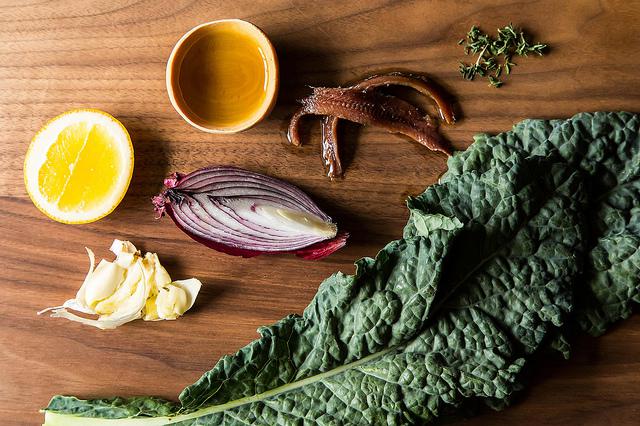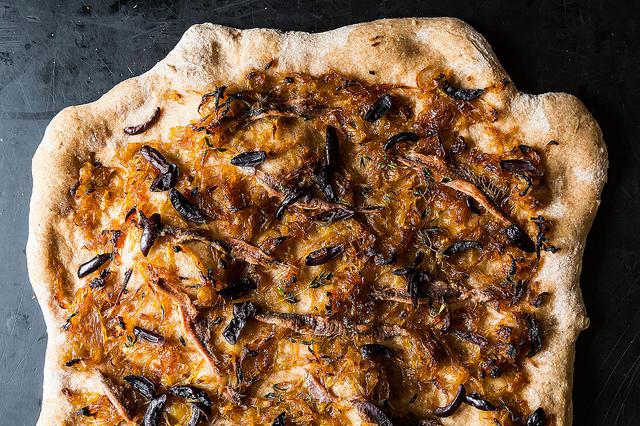Dinner vs. Child is a biweekly column about cooking for children, and with children, and despite children, originally published in Food52 and now appearing on Brow Beat. You can read previous installments of Dinner vs. Child here. You can read Day’s Slate blog about infancy, How Babies Work, here.
This week: Why anchovies make everything better, even for kids.
I have never bought into the idea that children gravitate toward gentle tastes.
Clearly some do! The child who will only eat white food exists; my wife was once that child. (Someday I want to hear about a child who only eats green food. I am willing to bet that such a child is alive in Brooklyn today.) But as many children gravitate toward aggressive tastes. They like food in primary colors: olives, feta, sardines.
It’s odd. There are children who want their food pitched at a low, reassuring hum. And then there are children who want their food turned up to eleven.

Photo by James Ransom
This makes no sense if you think of taste in terms of gentleness or aggressiveness. But it makes a lot of sense in terms of subtlety or obviousness. I do not mean to slander your child, who is obviously exceptional, but it should be said: children are not especially subtle creatures. Subtlety is apparently located in some recondite section of the prefrontal cortex which doesn’t develop until age 26. Subtlety for my son, Isaiah, is when he says YES and then pauses and says NO.
Children don’t gravitate toward gentle tastes. They gravitate toward obvious tastes. They tend to like tastes that are either YES or NO. The white food demographic is NO. And the anchovy demographic is YES. We tend to think of the latter as very challenging and adult, and the former as very child-like and timid. The child who eats anchovies is supposedly the adventurous eater. But both children want the same all-caps typeface.
I like anchovies in part because I feel, very vaguely, that my children should be eating more oily seafood than they are, and oily small fish are the simplest way to solve this problem.
But that’s peripheral: I like anchovies mostly because—and this an ancient anchovy koan—they make my cooking taste better than it actually is. They are the deathless friend of the last-minute, how-can-we-be-out-of-peanut-butter cook. They do not make things taste more like anchovies: like salt, they make it taste more like itself—a deeper, richer, more convincing version of itself. In this house, they disappear in these ways:
Hearty greens: Sauté garlic in olive oil, then melt in three or four anchovies. (I use the oil kind. I know I am wrong.) Add the raw greens, a little water, and sauté, covered, for five or so minutes.

Photo by James Ransom
Salads: On radishes. On kale. For bagna cauda dressing. I have nothing to add. (Fine: Genius anchovy vinaigrette. And anchovy aioli.)
Pasta: See hearty greens, plus chopped toasted walnuts or bread crumbs. The greens themselves are delicious but optional. (If post-bedtime, add drastically more garlic and anchovies and some dried chilies. There is no better bachelor meal. It is a bachelor meal in part because having consumed it you can be confident of remaining a bachelor.)
In case your small humans are suspicious, take note: The anchovies in all the above are either invisible or at least no larger than speck-size. They will never know.
The recipe below is for pissaladière, the onion-anchovy pizza from southern France. Caution: These anchovies are visible.
Mine is not a real pissaladière: it uses a more or less standard pizza dough; the dough should be thicker, or enriched. I would do that, but if I did I would never actually make it: When I make pissaladière I am almost always doing so unplanned. And pissaladière is the perfect pantry pizza: All you need are onions, anchovies, thyme. (For extra anchovy goodness, you can smear anchovy paste on the dough.)
It looks sophisticated. It looks adventurous. It is neither. It is shameless. And it is obvious.
Pantry Pissaladière
Makes one very large rectangle of onion-anchovy goodness
The Dough
2 1/3 cups bread flour (or 333 grams)
1/4 teaspoon instant yeast
1 teaspoon salt, plus a pinch (or 6 grams)
1 cup lukewarm water (or 220 grams)
The Toppings
3 large onions, sliced (about a couple of pounds worth, very roughly)
1 can of anchovies
1/4 cup kalamata olives, chopped
olive oil
fresh or dried thyme, a sprinkling
